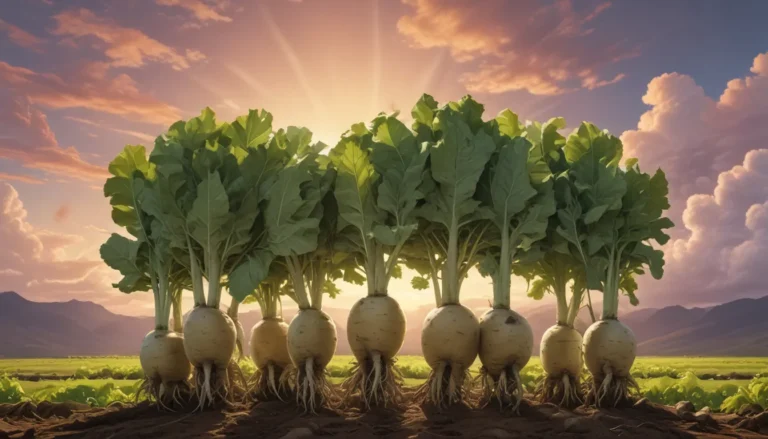Tips for Growing Golden Beets: A Complete Guide

When the cooler weather sets in, beet enthusiasts like me can’t help but think about the vibrant and versatile vegetable. Whether in soups, salads, or roasted to perfection, beets add a unique color and flavor to our meals. While red and candy-striped beets are popular options, golden beets have their own charm.
With a sweeter and less earthy taste, golden beets offer a delightful alternative to their counterparts. If you’re looking to expand your gardening horizons and try your hand at growing these golden treasures, you’re in for a treat.
In this comprehensive guide, we’ll delve into the world of golden beets, covering everything from cultivation and history to propagation, growing tips, cultivar selection, pest management, harvesting, preserving, and delicious recipes to try. So let’s roll up our sleeves and dig into the art of growing golden beets!
Cultivation and History
Golden beets, closely related to chard, amaranth, and spinach, have a rich history dating back to ancient times. Cultivated from sea beets in the Mediterranean region, beets were initially prized for their leaves by the Ancient Greeks and Romans.
Over time, they realized the culinary potential of the roots, leading to the cultivation of various beet varieties. Yellow beets emerged between the Roman era and the 1700s, eventually becoming the parent of modern sugar beets.
Golden beets, enriched with antioxidants called betalains, have a unique chemical composition that sets them apart from their red and purple counterparts. With higher levels of betaxanthin and a milder taste, golden beets are sweeter and less earthy, making them a popular choice among beet lovers.
Golden Beet Propagation
Beets thrive when grown from seeds rather than transplants due to their large roots. To ensure successful germination, soak the seeds in water for an hour or two before planting. Scarifying the seeds by nicking them with a nail clipper can also aid in the germination process.
Start seeds indoors in biodegradable pots if your growing season is short. CowPots, made from cow manure, are an excellent choice to minimize root shock during transplantation. Plant the seeds directly into well-prepared soil or sow them in containers under sufficient sunlight.
Maintain soil moisture during germination, and thin out seedlings once they reach three inches in height. Harden off indoor seedlings before transplanting them to the garden to acclimate them to outdoor conditions. For continuous harvest, sow beet seeds in batches every few weeks.
How to Grow Golden Beets
To achieve uniform and vibrant golden roots, prepare your planting area by removing rocks and ensuring adequate soil fertility. Incorporate compost or soil conditioner to improve soil structure and fertility, particularly in raised beds or containers.
Monitor moisture levels closely, ensuring the soil is neither too dry nor too wet. Water infrequently but deeply to encourage robust root growth and avoid cracked roots. Weed regularly to prevent competition for nutrients and sunlight, discouraging pests and diseases.
Vigilance is key in managing common beet pests such as aphids, nematodes, beetles, and maggots. Regularly inspect plants for signs of infestation and take prompt action using organic pest control methods. Rotate crops, space plants adequately, and maintain soil health to prevent diseases like mildews, rust, and rot.
Golden Beets Cultivars to Select
With a myriad of golden beet cultivars to choose from, selecting the right variety can be a delightful challenge. Consider popular options such as ‘Badger Flame,’ ‘Boldor,’ ‘Burpee’s Golden,’ ‘Detroit Golden,’ ‘Golden Boy,’ ‘Touchstone Gold,’ and ‘Yellow Mangel’ based on their flavor profiles, growth habits, and disease resistance.
Each cultivar offers unique characteristics, from vibrant orange skins and pale yellow flesh to savory, sweet flavors that complement various culinary dishes. Whether you prefer oblong roots, perfectly round bulbs, or elongated shapes, there’s a golden beet cultivar to suit every taste.
Experiment with different cultivars to discover your favorites and enjoy a bountiful harvest of golden treasures in your garden. Select seeds from reputable suppliers that support open-source seed initiatives to promote accessibility and sustainability in plant breeding.
Managing Pests and Disease
Maintaining good cultural practices is essential in preventing common beet pests and diseases from affecting your golden beets. While certain cultivars demonstrate resistance to specific issues, overall care is necessary to avoid infestations and infections.
Stay vigilant against insect pests such as aphids, leafhoppers, beetles, and worms by implementing integrated pest management strategies. Regularly monitor plants, remove weeds, and maintain soil health to deter pests and reduce the risk of infestation.
Beet diseases like mildews, rusts, and rot can be minimized through crop rotation, proper spacing, and timely watering practices. Prune affected foliage, remove infected plants, and apply organic fungicides as needed to prevent disease spread.
Harvesting
Timing is crucial when harvesting golden beets to ensure optimal flavor and texture. Watch for the roots to emerge above the soil surface, indicating readiness for harvest based on the recommended maturity period for each cultivar.
Avoid leaving beets in the ground too long, as overmature roots may become woody or cracked. Harvest beets promptly, taking care not to damage the foliage or roots during extraction. Trim greens as desired for fresh consumption or storage, reserving the roots for culinary use.
Preserving
Extend the shelf life of golden beets by storing them properly in a cool, dark location with adequate ventilation. Refrigerate fresh beets with greens attached for short-term storage or remove greens for longer-term preservation.
For extended storage, place cleaned roots in a container with water in the refrigerator to maintain freshness and crispness. Use softening roots for quick pickling, roasting, or cooking in various dishes to prevent waste and enjoy their unique flavor and texture.
Experiment with preserving methods like pickling, fermenting, or canning to preserve beet harvests for year-round enjoyment. Explore recipes and cooking ideas to incorporate golden beets into salads, soups, stews, and side dishes, adding a touch of sweetness and color to your meals.
Recipes and Cooking Ideas
Golden beets lend themselves well to a variety of culinary preparations, from roasting and grilling to pickling and fermenting. Enhance their natural sweetness by seasoning with herbs, spices, and acidic ingredients to create flavorful dishes that showcase their vibrant color and unique flavor profile.
Roast golden beets with olive oil, salt, and pepper for a simple side dish or add them to mixed salads for a nutritious boost. Pair golden beets with complementary flavors like anchovies, avocados, cilantro, or horseradish to create dynamic taste combinations that excite the palate.
Experiment with different cooking techniques and flavor pairings to discover new ways to enjoy golden beets in your favorite dishes. Explore online resources and cookbooks for creative recipes that highlight the versatility and enticing taste of golden beets in diverse cuisines.
Quick Reference Growing Guide
- Plant Type: Biennial root vegetable
- Native to: Mediterranean
- Hardiness (USDA Zone): 2-11
- Season: Spring, summer, fall, winter (warm regions)
- Exposure: Full sun
- Time to Maturity: Up to 90 days for roots
- Spacing: 3 inches
- Water Needs: Moderate
- Common Pests: Aphids, beet leafhoppers, cutworms, flea beetles
- Common Diseases: Alternaria leaf spot, powdery mildew, fusarium root rot
Stay Golden
As you embark on your golden beet growing journey, savor the process of cultivating and caring for these vibrant vegetables. Embrace the unique flavors, colors, and textures of golden beets as you explore different culinary preparations and preservation methods to enjoy their bounty year-round.
Share your gardening experiences, cultivar choices, and recipe creations with fellow beet enthusiasts to celebrate the beauty and versatility of golden beets in the garden and kitchen. Stay golden in your gardening endeavors and culinary adventures, spreading joy and deliciousness with each golden harvest.
Whether you’re a seasoned beet connoisseur or a beginner gardener eager to explore new horizons, growing golden beets offers a rewarding and flavorful experience. Enjoy the journey of cultivating, harvesting, and savoring these earthy delights, discovering the magic of golden beets in your culinary repertoire. Happy growing and cooking with golden beets!





